Carolle Benitah
Carolle Benitah was born in 1965 in Casablanca, Morocco. She worked as a fashion designer for 10 years and she studied at the École de la Chambre Syndicale de la Couture Parisienne (promotion 1991) and she graduated from École Nationale Supérieure de la Photographie in Arles, France, with the Jury’s distinction in 2015. In 2001 she turned to photography as well, due to wanting to change her career path and life due to challenging personal circumstances at that time in her life and a period of strong personal questioning.
She began taking photographs of her son, herself and her family, so she could document her every day life. Soon she was drawn in by the discovery and the process of her own questioning, so she enrolled herself in art school. During this year she became ill and documented this life experience.
She transformed her photographs into three-dimensional pieces. She used the decorative form of embroidery to present her milieu’s flaws. It is also a metaphor of itself to carolle benitah, because to embroider a photograph it will first make holes in the paper. It is a process. There is something sacrificed to work on a photograph. It’s a violent and painful treatment. ‘I drill, I cut, I erase, I crop and I’ll remove some elements.’ It is also a reflection of the time, the time it will take to embroider each photograph and also the time that has passed between the moment when the photograph was taken and now. It is her way of revisiting her own story with experience and time spent. ‘It’s like crossing the mirror. I go back and I recreate another story.’
During her work in photography she explored memory, family and the passage of time. Often pairing old family snapshots with handmade accents, such as embroidery, beading and ink drawings, Bénitah seeks to reinterpret her own history as daughter, wife, and mother. Her work questions the themes of identity and self construction, while exploring subjects such as family, desire, loss, mourning and confinement. She did this by taking on challenging themes and drew on difficulties from her own past. She also drew on her past as a fashion designer by using materials that populate the domestic world (placemats, monogrammed handkerchiefs, tea towels, wedding trousseau linens, etc.) and trivial objects which she creates and embroiders, she overturns the hierarchy of the arts.
During her work of Photo Souvinirs she began to explore other mediums. She began to embroider setences on paper doilies, phrases that question love and desire.
‘Tell me you love me, tell me once more that you love me, tell me one more time that you love me.’ – This reflects a kind of insecurity and urgency of desire. She continued to explore these obsessions by creating an installation of 11 handkerchiefs embroidered with monograms depicting impossible expectations, such as ‘Im waiting for Mike Brandt, my idol of 10 years old, to come back from the grave and tell me he wants to marry me.’ She embroidered these onto pillows, with an embroidered crown in the middle of the pillow and the phrases around the outside of the pillow.
The work of Carolle Bénitah has been published in magazines such as Leica World, Shots Magazine, Photos Nouvelles, Spot, Center for Photography Houston, Foto Noviny, and Lens Culture, among others.
She then passed away April 1st 2024 due to a short illness at age 59 in Arrondissement, Marseille, France.
About Photo Souvenirs
In her work Photo Souvinirs she used old family archives, snap shots. She chose specific photographs cropped them and embroidered them. In doing so she explored her identity and reconstructed this, as well as exploring the themes of family and difficult experiences in her own life.
She titled her work ‘Photo Souvenirs,’ because it includes three periods: childhood, adolescence and adulthood and the collection of images ends in the early 2000’s when she started documenting her own life. Each period corresponds with a colour. She built an album for each period and in each album there are 15 images. Childhood is represented with red, which is the colour of violent emotions. Adolescences is represented by black, which is the colour of anxieties related to the period, and adulthood is represented with gold, which is the colour of fulfillness in love. She used the colour corresponding thread for her embroideries in each of these periods.
Her series Photos-Souvenirs was also selected to exhibit in FotoFest’s 2014 Discoveries of the Meeting Place showcase of past Biennial portfolio reviews.
A short video about Carolle Benitah, made by another friend, Marie Docher.
Interview (2010)
I started to be interested in my family pictures when I was leafing through a family album and found myself overwhelmed by an emotion of which I could not define the origin.
These photographs were taken 40 years earlier, and I could not even remember the moments they were shot, nor what preceded or followed those moments.
But the photos reawakened an anguish of something both familiar and totally unknown, the kind of disquieting strangeness that Freud spoke about. Those moments, fixed on paper, represented me, spoke about me and my family, told things about my identity, my place in the world, my family history and its secrets, the fears that constructed me, and many other things that contributed to who I am today.
I decided to explore the memories of my childhood to help me understand who I am and to define my current identity.
To begin, I carry out “excavations”. Like an archeologist, I dig out the pictures in which I appear from family albums and the shoe boxes full of photographs. I choose snapshots because they are related to memories and to loss.
These photographs are fragments of my past. I interpret them from a subjective perspective as confessions. I order them, classify them, scan them, then I print them. I don’t do anything directly on the original photo; I transpose this reality on a different paper. Sometimes I crop a detail that calls out to me, and I choose my format. The work of interpretation begins with these steps.
Once these choices of images are made, I start to tell my version of the story. I turn my attention to my own history, sometimes with 40 years of distance and the life experiences that changed my perception of events. The past of a human being, unlike the remains of an antique temple, is neither permanent nor finished, but reconstructed in the present time.
For the next step, I add needlework: embroidery and beads.
Embroidering is primarily a feminine activity. In the past, the embroiderer was seen as a paragon of virtue. Waiting was tied to this activity: women embroidered, hoping for the return of the man to the home. Embroidery is intimately linked to the milieu in which I grew up. Girls in a “good family” used to learn how to sew and embroider — essential activities for “perfect women”. My mother embroidered her trousseau.
There is nothing subversive about this activity, but I pervert it with my purpose.
I use its decorative function to re-interpret my own history and to expose its failings.
The two activities — interpretation and needlework — come together again in a kind of dispute: embroidery is the sign of a good education yet the words that I speak don’t show me to be what I was supposed to be: a well behaved girl, a wise spouse and a loving mother.
With each stitch I make a hole with a needle. Each hole is a putting to death of my demons. It’s like an exorcism. I make holes in paper until I am not hurting any more.
—Carolle Benitah
Her Work
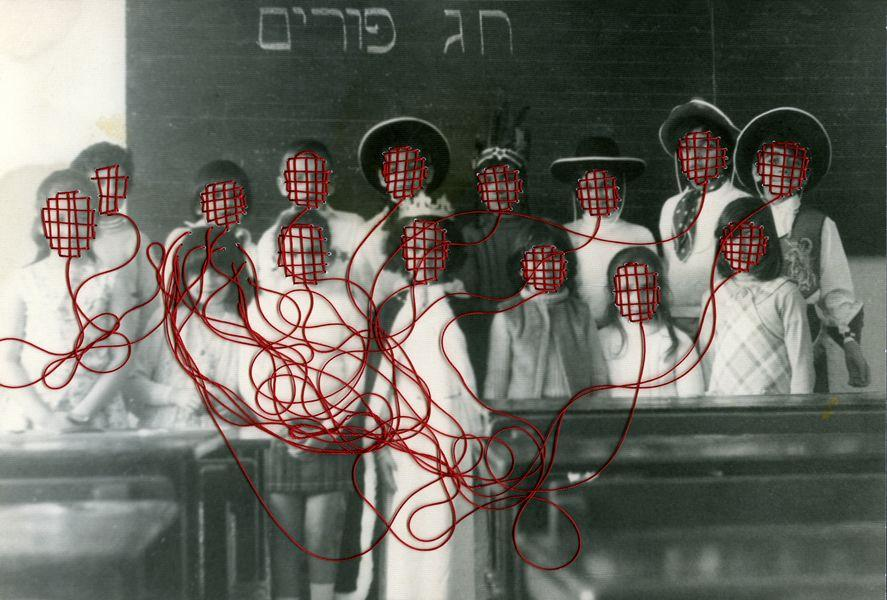
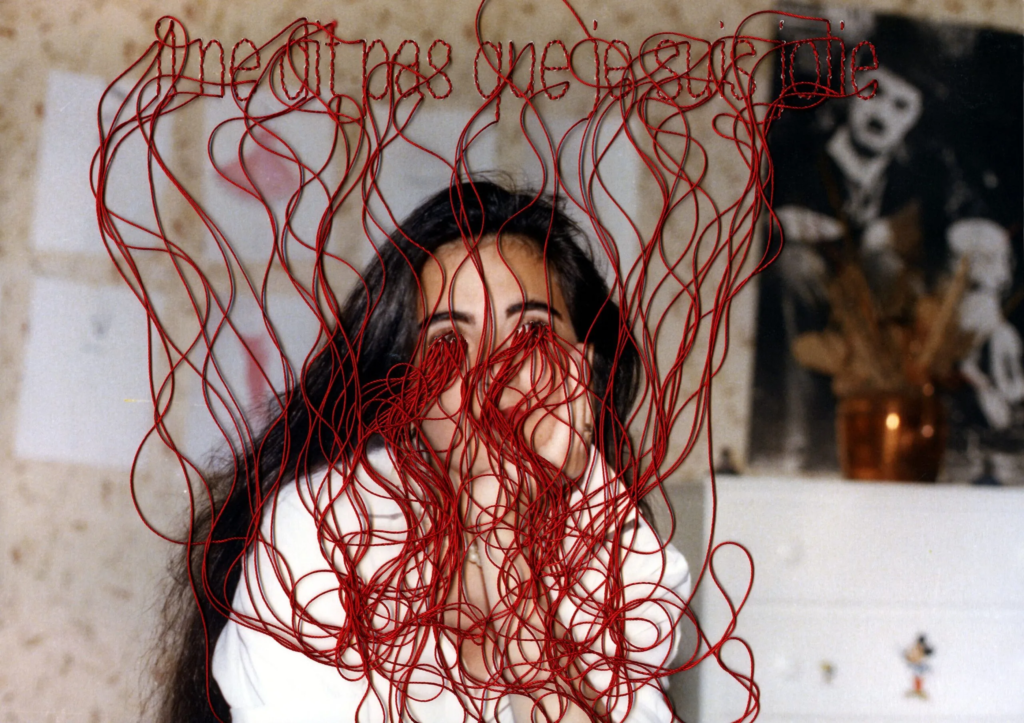
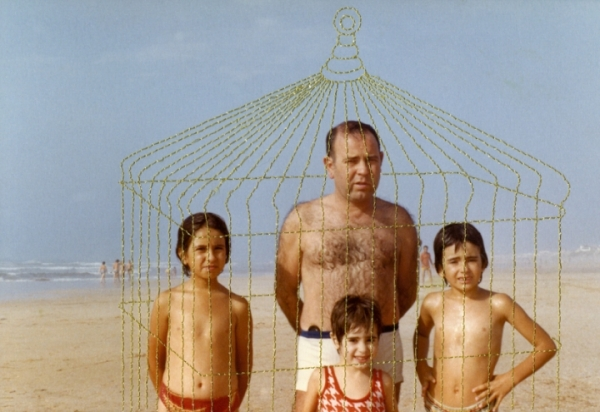
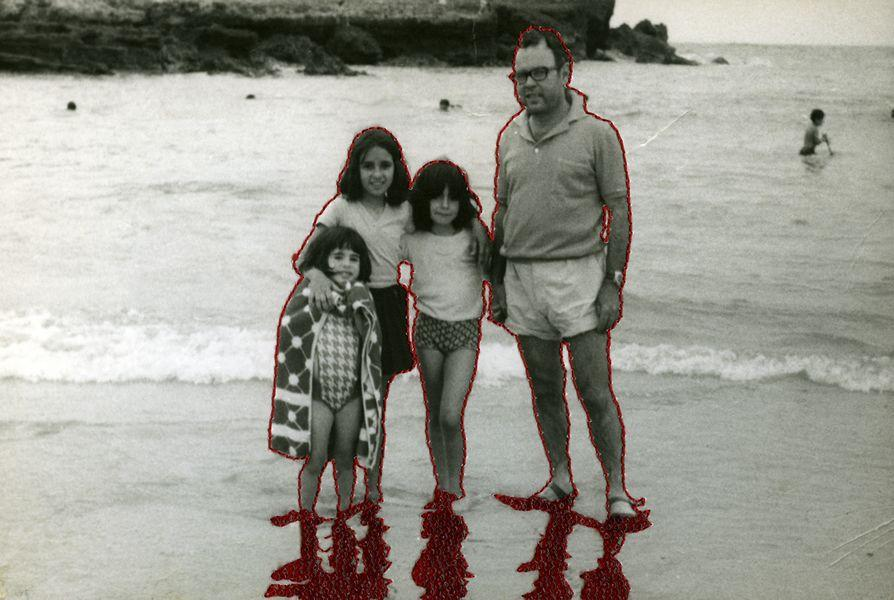
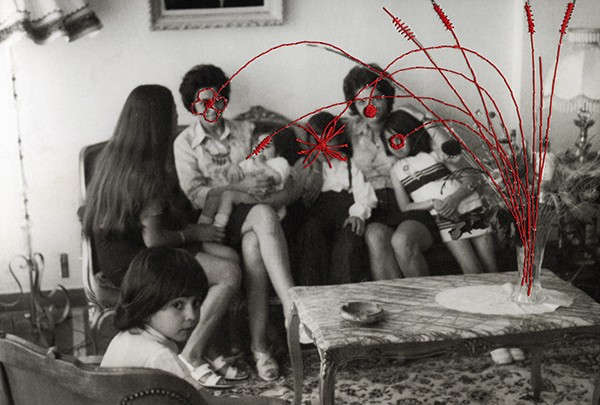
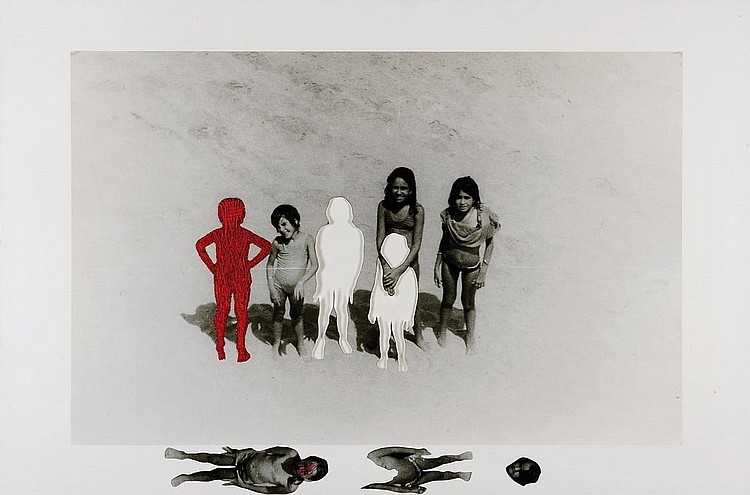
Analysis of 1 Image
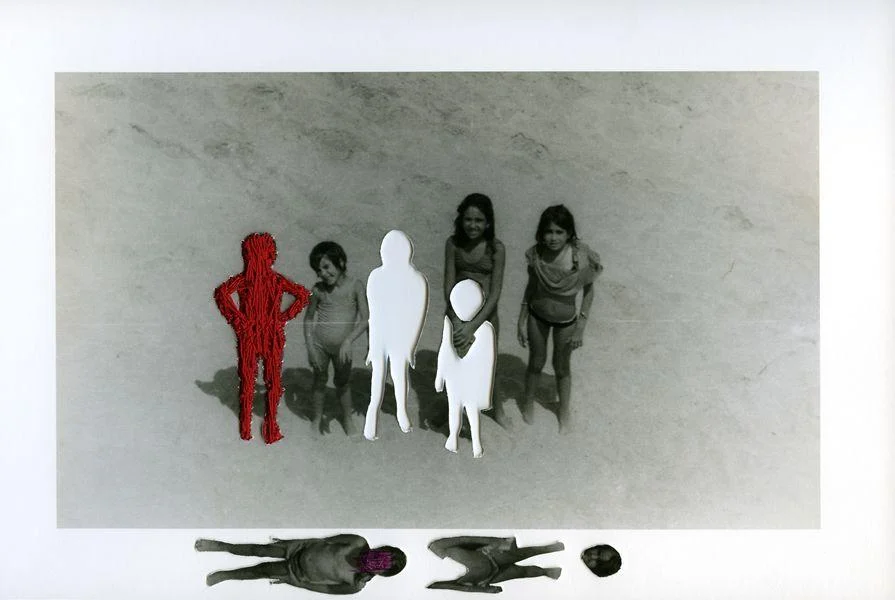
This image is an archive image, which looks to be taken outside on a beach. Therefore, it would use natural daylight as the lighting source. The subjects in the image are posed how they wish, so they have high levels of control and the person taking the photograph also has high levels of control, because they can manipulate the distance of themselves, as well as angles and positioning.
This image is a black and white image with high levels of contrast, due to the light and dark tones throughout. This image also contains the colour red, due to embroidered stitching in the photograph. This creates a three dimensional image, with texture. There is also more texture, due to the two figures, which are cut out and then stuck at the bottom of the page. The arrangement of this archive image was manipulated, due to the deconstruction of the image. Carolle Benitah manipulated this layout, as she arranged the cut out figures and stitching as she wished, which indicates high levels of control. She has also manipulated the cut out figures, so they are stuck outside the frame of the original image. I think the main viewpoint of this image is the red stitched figure, who I believe to be Carolle Benitah. This is the main viewpoint, because the pop of colour leads the eye to this figure. The pop of colour also creates a contrast between the black and white background. All the figures are in the centre of the frame.
The red stitching in this image reflects violent emotions during Carolle Benitah’s childhood, as this archive is also an image from her childhood. The meaning of this image is to explore Carolle Benitah’s childhood and see how her experiences and life has changed over time. She also explores family and identity in these images in her work of ‘Photo Souvenirs.’
My Inspiration
I am taking inspiration from Carolle Benitah’s work, because I am also using family archives in my work, and I will also be deconstructing them in the same way benitah has. I want to experiment with stitching as well, but in a slightly different way. I want to use stitching to show how my family and I are all connected through blood, DNA, love and similar characteristics. I will also be using red stitching, but instead of it representing violent emotions, like it does in benitah’s work, it will symbolise blood, so it can metaphor my family’s blood line.
I also want to experiment with the concept of time and how families can change and grow over time. Benitah also experienced how her life has changed from when her archives were taken to her current life, while making this work and the embroidery metaphors this, because of the time it takes to embroider a photograph. I want to use this same metaphor in my work.
In order to create these embroidered photographs, I will use photoshop, but I may experiment with actually stitching a hard copy of an image, so I can understand Carolle Benitah work better and the time it takes to do so.

Jessica, good blog posts on research, analysis and contextual studies. Now focus on producing photoshoots and create new images in response.